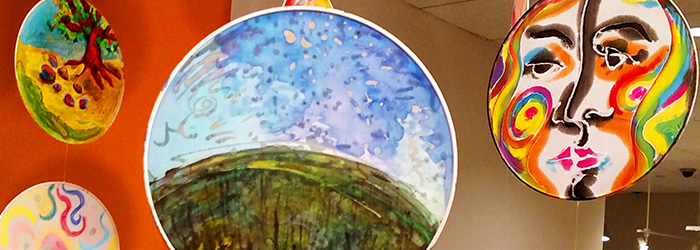By John DiConsiglio
As a second-year graduate student in the GW Art Therapy Program, Lida Sunderland learned how to use materials like clay and colored pencils to help clients work through their emotional pain. She’s employed art therapy interventions such as mask-making-as-metaphor to reveal a person’s inner struggle and Jungian mandalas, circular designs that promote focus and reflection.
But there’s one tool she’s never used, whether in internships, clinical settings or classrooms: adult coloring books.
“Don’t get me wrong, I think they are great,” she said of the trend that has taken the publishing world by storm. “Like Sudoku or crossword puzzles, they can be a terrific leisure activity. But you’ll never see one in an art therapy class.”
That’s because, while millions of adults are caught up in the coloring craze and half of Amazon's top 10 best-selling U.S. titles are adult coloring books, experts like Assistant Professor of Art Therapy Donna Betts recommend approaching them with caution. Coloring books may be a relaxing and enjoyable means to unwind, but they are very definitely not art therapy.
“We all have our own ways of zoning out: cooking, gardening, coloring. And that’s fine,” Betts said. “But art therapy is so much more.”
As president of the board of directors for the American Art Therapy Association (AATA), Betts has watched with some concern as adult coloring books labeled as “art therapy” fill racks and rows at bookstores. And while she praised coloring as a beneficial self-help activity, she and her colleagues worry about titles like Color Therapy: An Anti-Stress Coloring Book and Disney’s Frozen Art Therapy Coloring Book. By marketing themselves as “art therapy” activities, Betts said, the books come dangerously close to blurring the line between a hobby and a mental health profession that treats clients with conditions ranging from post-traumatic stress disorder to Alzheimer's disease.
A Therapeutic Relationship
| Donna Betts |
Perhaps the most fundamental and critical difference between coloring books and art therapy, Betts noted, is the presence of a trained and certified clinicians. “The therapist and the therapeutic relationship are integral to the patient’s healing,” she said. In art therapy sessions, therapists oversee the artmaking process and use their expert observations to help clients untangle the messages in their creative efforts. Far from merely decorating coloring books’ floral arrangements and geographic designs, art therapy allows people to communicate painful feelings and traumatic experiences that may be too difficult to express in words. “The client is speaking to the therapist and to him or herself through the artwork,” Betts said.
Likewise, while the constrictive nature of adult coloring books—most present elaborate but ready-made outlines—may validate a reassuring desire to color within the lines, it also prohibits users from creating their own designs. “Coloring books don’t work that way,” Betts explained. “They limit artistic and personal expression; the creative processes aren’t being truly tapped into.”
Betts has recently fielded more queries on coloring books than any other art therapy-related topic. Along with her AATA colleagues, she has advised publishers and retailers on ways to more accurately market and display their products without sending misleading messages. And she stopped short of promoting coloring as a stress reliever, as studies confirming this claim are lacking. AATA has also entered a joint marketing agreement with adult coloring book leader Dover Publishing to include professional art therapy resources with their materials.
Betts theorized that the coloring phenomenon may be a backlash to a tech-obsessed society. “We have too many screens in our lives,” she said. “Maybe people are going back to coloring books because they are tactile; they are a way to engage with something that involves using your hand on a piece of paper.”
Meanwhile, both Betts and Sunderland look at the rise of adult coloring books as an opportunity to start a conversation about art therapy. While a widely respected integrative mental health profession, art therapy still faces challenges winning acceptance in the health care world and, to some extent, among the general public. As an art therapy student, Sunderland sees her role as an advocate and educator for the discipline—even if it means using coloring books as an icebreaker. “It’s a chance to reach out to people and explain what we do," she said.



